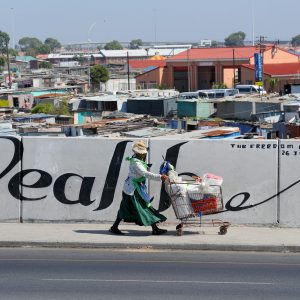New energy regime will deepen inequality
If the state and workers collaborate, however, new rules for electricity generation could benefit all as small-scale renewable energy plants add power to the grid – and to the people.
Author:
18 November 2020

The Department of Mineral Resources and Energy recently announced legislative changes that allow municipalities to develop small-scale capacity to generate electricity. This will weaken Eskom’s monopoly over electricity sales, encourage renewable energy generation and allegedly open a path for municipalities to chart a just recovery for the economy.
To understand whether these developments will transform the economy or simply deepen existing faultlines, it is important to map the dynamics that prompted this shift.
The government’s October budget is intent on an “infrastructure-led” economic recovery plan, with President Cyril Ramaphosa set to solicit private investment to restimulate the economy. Minister of Finance Tito Mboweni also confirmed the move to unbundle Eskom into separate generation, transmission and distribution companies.
Procurement for large-scale energy infrastructure is determined by the government’s Integrated Resource Plan (IRP). This includes new Eskom projects and private independent power producers (IPPs), which largely consist of renewable energy resources. IPPs make use of power-purchasing agreements, typically covering a 20 to 25-year period, that define the tariff of electricity sales and quality of supply conditions, among other factors.
Related article:
The City of Cape Town, run by opposition party the Democratic Alliance, has historically played a prominent role in lobbying for municipal generation as part of a broader effort to increase the participation of private enterprises in the energy sector. The City has gone as far as developing its own mini-integrated resource plan, dividing its anticipated generation capacity into smaller projects for which private entities can bid.
This means participating municipalities will have to secure substantial investment finance, as renewable energy systems tend to require a large initial capital outlay. This will privilege larger metros such as Cape Town and Johannesburg, which have a higher likelihood of raising money for new projects.
In addition, as is the case with IPPs at the national level, municipalities will need to assume a significant portion of the contractual risks of new projects to provide greater security for investors. This could end up effectively excluding the participation of municipalities that are already struggling.
Municipal electricity generation in South Africa
Municipal generation is not new in South Africa. Early utility-scale electricity generation has its roots in private power provision to increase mechanisation in the lucrative mines of the Witwaterstrand in the early 20th century.
As wealthy, largely white residents and commercial enterprises began to make use of an expanding array of consumer electronics, municipal coal-powered plants were built to meet the rising suburban demand, alongside increasing demand in the mines during the early phases of industrialisation.
Growth in the mining sector attracted local and international capital for early power plants, with land and coal mine owners competing to secure concessions to build transmission lines and acquire favourable purchase agreements.
Related article:
Eskom, initially Escom, was developed as a formidable state-owned enterprise through the expropriation of private plants and, following waves of strikes at municipal plants, limiting municipal generation. This formed a state monopoly for electricity generation, transmission and distribution.
As houses, mines and factories began using more electricity, a national grid was formed, connecting previously separate power networks across South and Southern Africa. Large-scale plants were built in strategic areas, allowing for the dispatch of energy to other parts of the country. Eskom began to benefit from economies of scale.
A turn towards neoliberal economic policies, widespread corruption and mismanagement, and a steady decline in the manufacturing and mining sectors, has prompted the move to unbundle Eskom’s operations. The state’s monopoly in the energy sector is now unravelling.
The myth of municipalities going off grid
The complexity of procurement procedures will prove a hurdle for municipalities, and it remains unclear what role the National Treasury will play in mitigating risk for the projects.
Officials promoting municipal generation through new private, potentially renewable energy plants say it will reduce dependency on Eskom, assuring residents and commercial enterprises of a consistent supply during load shedding.
Despite remarks from the media that these developments imply municipalities will go “off grid”, the reality is that these plants feed into the existing national grid, which offers stability, storage and additional capacity.
Related article:
This is true for countries such as Germany and Denmark, with high levels of renewable energy in their national grid. They benefit from the stability offered by their physical grid connections to neighboring state’s power systems. Services such as NordPool and the European Power Exchange, connecting 16 and 8 countries respectively, derive energy from an array of sources across Europe with complementary characteristics.
Far from being independent of public grids, private generation is reliant on public infrastructure to dispatch power, and to maintain and sustain the networks from which IPPs solicit profits. It is, in essence, a public-private partnership.
Legislative clarity is slowly emerging on the rules for decentralised private electricity generation, but it is clear that as private generators sell more reliable supply solutions to businesses and industries of various scales, Eskom stands to lose massive amounts of money. This despite its network infrastructure itself being central to the economic viability of the small-scale private energy solutions.
A turn towards worker-run industries
A report by the Public Affairs Research Institute discusses the effect of the development of Eskom’s Medupi power station on the expansion and development of the Lephalale local municipality.
The boom in economic activity in the area, stemming from investment by Eskom and coal giant Exxaro, led to an increase in the municipality’s population and subsequently in electricity demand. The municipality, like most across the country, carries the weight of racial segregation characterised by unequal access to basic infrastructure, compounded by rapid urban growth. The municipal funding system is reliant on the collection of rates and water and electricity tariffs, which disadvantages under-resourced municipalities such as Lephalale. These municipalities battle to raise the capital to build new infrastructure, particularly in shack settlements. Self-organised connections are routinely used by residents, and municipalities cannot meet their financial obligations to Eskom. Without the implementation of significant reforms, these trends in inequality will continue to grow between differently resourced municipalities, and between the impoverished and the wealthy.
In February, the Congress of South African Trade Unions put forward a proposal to the National Economic Development and Labour Council for an Eskom bailout using workers’ pensions invested in the Public Investment Corporation, the Investment Development Corporation and the Development Bank of South Africa.
The call accompanied requirements for a comprehensive forensic audit of Eskom, along with decisive action against corruption. National Union of Metalworkers of South Africa (Numsa) deputy secretary Karl Cloete criticised the proposal as focused on covering the outstanding debt and “saving Eskom” without giving clarity on how to finance the energy transition.
Much needs to be debated by workers on the proposal to use pension funds to bail out Eskom. But what is not being foregrounded is how refinancing Eskom with workers’ pensions could be used to increase worker control of the state-owned enterprise through governance reform, shifting from its present neoliberal corporate structure.
Related article:
Coordination between state instruments and worker committees in failing manufacturing companies facing imminent closure could explore, experiment and materially support the seizure of these companies to re-establish manufacturing under state ownership or worker self-management. The devastating impact of the current economic crisis is an opportunity to take a chance on ourselves rather than solutions that prioritise bailout funds for large corporations under the gospel of trickle-down economics.
Once these companies are seized, they could repurpose a portion of the industries’ productive capacity to develop products and materials for renewable energy systems, among other products providing basic services, that could be used locally and exported when in surplus. Smaller-scale municipal plants to generate renewable energy, financed by union finance instruments and pension funds, could then be built, in part, to benefit a new state or worker-controlled manufacturing plant, linking the benefits of economic small-scale generation technologies to stimulate the planned development of labour-intensive industries. If public land is used, parasitic rental agreements with wealthy landowners can be avoided for these new infrastructure developments.
To support this shift, it will be crucial to leverage technical skills in universities and technical and vocational education and training colleges to develop infrastructure solutions compatible with community ownership and worker self-management. These centres of learning should develop programmes that introduce cooperative development planning, along with courses to upskill technical workers interested in transforming existing enterprises.
Opportunities for municipal generation linked to cooperatives in waste recycling and energy and food production have been outlined by the Alternative Information and Development Centre and deepened by coalitions such as the Co-operative and Policy Alternative Center and the Climate Justice Charter.
Related article:
In the spirit of the Soweto Electricity Crisis Committee founder Trevor Ngwane’s remarks, “Electricity and water are basic necessities which every human being should have access to. Electricity is produced by the workers – they pay twice as they pay with labour and they pay with cash…”
The 2012 resolution of Numsa’s ninth congress asserted the need for social ownership as a potentially important strategy for the working class to stop private interests coopting renewable energy technology in the name of environmentalism and market efficiency.
Municipal generation should not be used by private developers to cash in on low-risk investments backed by the state. Rather, it could present a way to socialise the ownership of the sector at a small scale as part of the broader strategy to meet the basic needs of the majority of South Africans.
This article forms part of work towards the Tricontinental: Institute for Social Research’s energy project.





